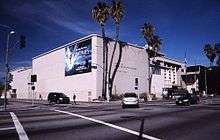Association of Moving Image Archivists
The Association of Moving Image Archivists (AMIA) is a 501(c)(3) not-for-profit organization established to advance the field of moving image archiving by fostering cooperation among individuals and organizations concerned with the acquisition, description, preservation, exhibition and use of moving image materials.
 AMIA Logo | |
| Abbreviation | AMIA |
|---|---|
| Formation | 1990 |
| Type | 501(c)(3) |
| Legal status | Articles of Association |
| Purpose | Professional Body |
| Headquarters | Los Angeles |
Region served | Worldwide |
Membership | 1,017 (as of Nov, 2015) |
Official language | US English |
President | Andrea Kalas |
Main organ | Board of Directors |
Staff | 3 |
Volunteers | 200 approx. |
| Website | www |
History

Since the late 1960s, representatives from moving image archives have recognized the value of regular meetings to exchange practical information and experiences.[1] Over the years, this group of archivists originally known as the Film and Television Archives Advisory Committee (F/TAAC) expanded from a handful of participants to several hundred archivists from over 100 national, regional and local institutions. In 1990, the name of the group was changed to the Association of Moving Image Archivists. In 1991, AMIA voted to formalize as an individual-based member-based professional association, the only one of its kind in the moving image archival field. Although AMIA's office is based in the US, its membership is now drawn from across the world.[2]
Membership
Membership is open to anyone who has an interest in the preservation of moving images and associated sound recordings: in practice, most of the membership are professional archivists (both public sector and commercial) and people working in associated professions, e.g. librarianship, the film and television industry or academics in related fields. AMIA offers both individual and institutional membership.
Governing structure
AMIA is governed by a Board of Directors, which is elected by the membership on a two-year cycle, and chaired by a president. The Board oversees and ratifies the work of the sub-groups through which the work of the organization is undertaken. The last significant changes to the governing structure were undertaken in 2009, when the present structure of committees and task forces was introduced.
Current President
- 2018-2019: Dennis Doros[3]
Former Presidents
- 2016-2017: Andrea Kalas
- 2012-2015: Caroline Frick
- 2009-2011: Wendy Shay
- 2005-2009: Janice L. Simpson
- 2003-2005: Milt Shefter
- 1999-2003: Sam Kula
- 1997-1999: Linda Tadic
- 1996-1997: Andrea Kalas
- 1995-1996: Maxine Fleckner Ducey
- 1994-1995: Eddie Richmond
- 1993-1994: Ernest Dick
- 1992-1993: Chris Horak
- 1991-1992: Bill Murphy
Committees and Task Forces
AMIA is a volunteer based organization and projects rely on work done by its members in Committees and Task Forces.
- Committees of the Board carry out the core management and policymaking functions of AMIA, e.g. running elections and organizing the conference. Chairs are appointed directly by the Board of Directors, and although their members are volunteers drawn from within the wider AMIA membership, the rosters of Committees of the Board have to be approved by the Board.
- Committees of the Membership are the bodies through which AMIA's professional presence in the field exists. They develop expertise, advocacy and education in the different topics and activities related to moving image archiving, e.g. preservation, copyright and cataloguing. Their rosters are volunteers from within the AMIA membership, and they elect their chairs directly.
- Task Forces are created by the Board of Directors to carry out a specific projects which does not fall squarely within the remit of an existing committee, and are dissolved on completion of that task.
See also
- Coordinating Council of Audiovisual Archives Association[4]
- UNESCO Memory of the World
- UNESCO World Day for Audiovisual Heritage
- National Film Preservation Foundation
- Film preservation
- Optical media preservation
- Lost film
- Orphan film
References
- For further information on the emergence of formal representation for the audiovisual preservation sector in the United States, see Anthony Slide, Nitrate Won't Wait: A History of Film Preservation in the United States, Jefferson, NC, McFarland (1992), pp. 81-84.
- See also Tom McGreevey and Joanne L. Yeck, Our Movie Heritage, New Brunswick, NJ, Rutgers University Press (1997), pp. 63-64.
- "The Association of Moving Image Archivists - Board + Staff". amianet.org. Retrieved 2019-01-30.
- Coordinating Council of Audiovisual Archives Association Archived 2014-12-21 at the Wayback Machine